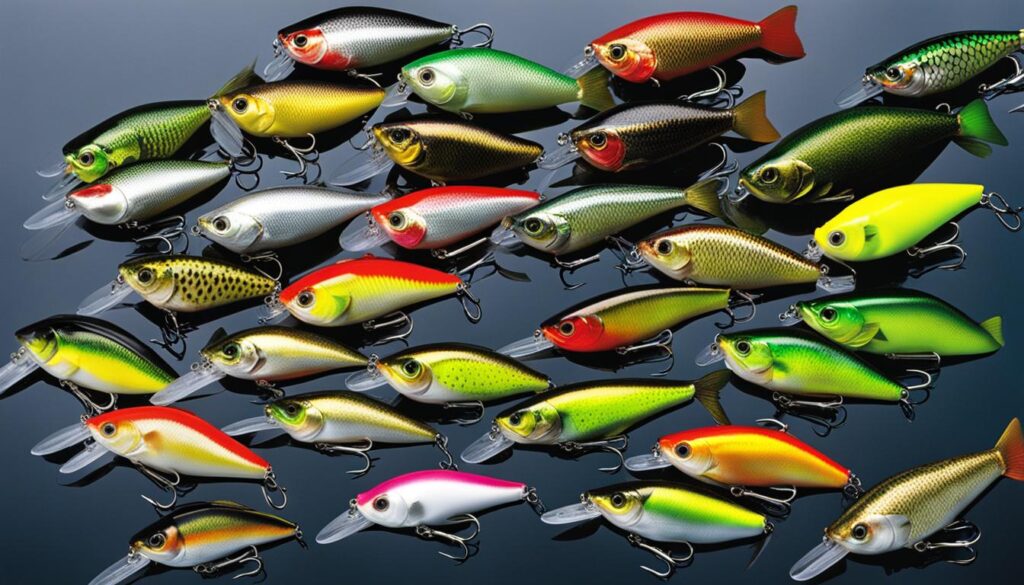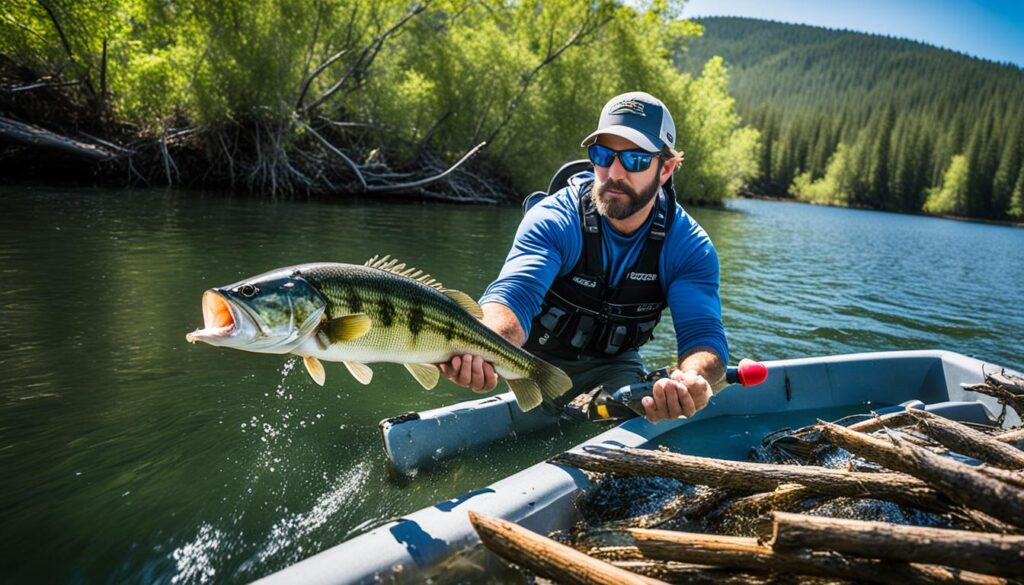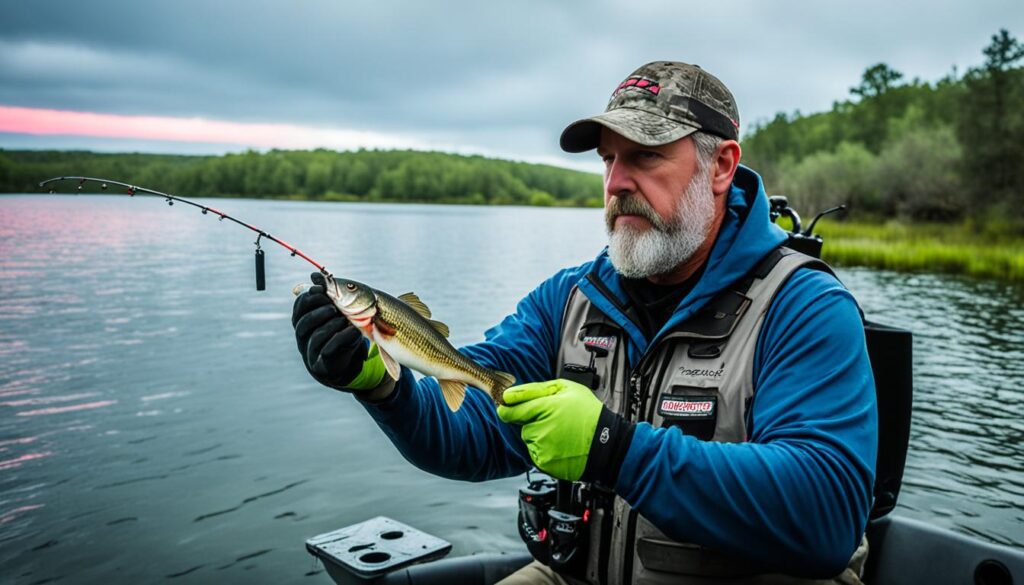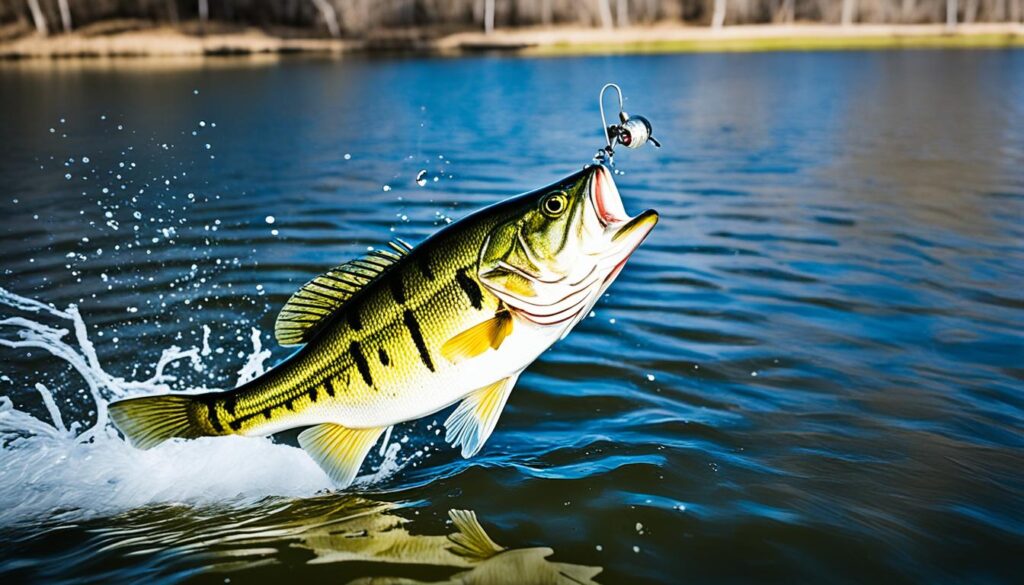Are you ready to up your bass fishing game during the prespawn season? Look no further than squarebill crankbaits. These versatile lures are a go-to choice for anglers targeting prespawn bass. With their large profile, hard wobble, and ability to deflect off cover, squarebill crankbaits are a winning combination for attracting and triggering reaction bites from bass.
Key Takeaways:
- Use larger squarebill crankbaits to target big prespawn bass and entice bites from smaller bass.
- Accurate target casting and off-cadence directional changes can make all the difference in getting fish to commit.
- Target cover elements such as rocks, stumps, and grass to increase your chances of triggering bites.
- Experiment with bait size and presentation techniques to find what works best for prespawn bass.
- Consider using lipless crankbaits in combination with squarebill crankbaits to cover more water and locate active fish.
The Importance of Cover and Target Casting
One of the key factors in successful prespawn fishing with squarebill crankbaits is targeting cover elements and making accurate casts. Bass tend to seek out cover during this time, and squarebill crankbaits are designed to bounce off hard cover and tickle the tops of grass. By accurately casting to cover elements such as rocks, stumps, and grass, anglers increase their chances of triggering bites from prespawn bass.
Shaw Grigsby, a renowned fishing expert, recommends using an upsized rod and line to handle the larger baits and fish around cover. Making regular contact with cover and working the bait with various retrieves can make a significant difference in the number of bites and the size of the fish caught.
“Accuracy is key when targeting cover with squarebill crankbaits. You want to make every cast count and closely mimic the natural movement of prey. By bouncing the bait off cover and performing various retrieves, you’ll evoke a reaction strike from those hungry prespawn bass.”
When using squarebill crankbaits, it’s essential to consider the fishing tackle for prespawn bass. The right gear, such as an upsized rod and line, will enable you to handle larger baits and navigate through cover with ease. By targeting prespawn bass in and around cover, you maximize your chances of getting those aggressive bites.
Working the Bait
To effectively target prespawn bass, it’s crucial to work the bait with different retrieves. The key is to imitate the natural movement of baitfish and provoke a reaction from the bass. Try techniques such as:
- Pumping: Quick and short jerks of the rod to create a darting action.
- Pausing: Temporarily stopping the retrieve to simulate a wounded or vulnerable prey.
- Twitching: Small, erratic movements of the rod tip to mimic the erratic behavior of injured baitfish.
By incorporating these variations into your retrieve, you’ll trigger bites from prespawn bass that may be hesitant to commit to a steady retrieve.
Remember to experiment with different casting angles and retrieve speeds as well. Sometimes, slow and steady retrieves work best, while other times, a fast and aggressive approach is more effective. Pay close attention to the behavior of the fish and adjust your presentation accordingly.
Check out the image below to see an example of accurate target casting with a squarebill crankbait:
Accurate target casting and working the bait around cover are essential techniques when it comes to targeting prespawn bass. The combination of precise casts to cover elements and enticing bait movement will increase your success rate in hooking onto those quality prespawn bass.
Bait Size and Presentation

When it comes to squarebill crankbaits for prespawn bass fishing, bait size can make a huge difference in your success. Shaw Grigsby, a renowned fishing expert, recommends using larger baits during this time. Prespawn bass are looking for an easy meal that requires less energy to consume, so a bigger bait can be more appealing to them. Not only does this strategy attract larger fish, but it also entices bites from smaller bass. By offering a larger meal, you increase your chances of catching bigger average-sized fish while still attracting the attention of smaller ones.
However, bait size is not the only factor to consider. The presentation of the bait is equally important in maximizing your success with squarebill crankbaits. While a straight and steady retrieve can catch fish, Grigsby emphasizes the effectiveness of adding subtle movements to your presentation. Pumping, pausing, and twitching the bait can create off-cadence changes in its direction, triggering reactive strikes from prespawn bass.
“When using squarebill crankbaits, it’s all about making that bait look like something alive and vulnerable. I like to give it some twitches, pauses, and erratic movements. This really imitates a baitfish that’s injured, and it’s simply irresistible to those prespawn bass.” – Shaw Grigsby
By incorporating these presentation techniques, you mimic the behavior of injured baitfish, making your squarebill crankbait appear more irresistible to prespawn bass. So, don’t be afraid to experiment with your retrieve and add some subtle movements to your bait. It could be the key to triggering those reaction bites and landing more bass.
Keep in mind that bait size and presentation go hand in hand. As you use larger squarebill crankbaits, adjusting your presentation to mimic injured baitfish becomes even more crucial. The combination of a bigger meal and lifelike movements can be irresistible to prespawn bass and significantly increase your chances of a successful fishing trip.
Utilizing Lipless Crankbaits in Combination
In addition to using squarebill crankbaits, another effective lure for catching bass during the prespawn season is the lipless crankbait. Professional angler Gerald Swindle often combines these two baits to target bass staging on deeper grass flats. Lipless crankbaits are particularly useful for covering large areas of water and locating pockets of fish.
When fishing with lipless crankbaits, Swindle recommends using a technique similar to that of fishing with jigs. By adding subtle nuances to the retrieve, such as pauses and twitches, anglers can increase their catch rates and average fish size. Depending on the mood of the fish, squarebill crankbaits can also be used as an alternative presentation or mop-up bait.
By incorporating lipless crankbaits into your arsenal, you can expand your options and increase your chances of success when targeting prespawn bass in early spring.
| Lipless Crankbait Benefits | Tips for Success |
|---|---|
| Ability to cover large areas of water | – Fish in a fan-shaped pattern, covering different depths and angles. – Vary the retrieve speed to determine what triggers bass to bite. – Pay attention to subtle changes in bottom composition or structure that may hold fish. |
| Effective for locating pockets of fish | – Cast near visible cover, such as weed lines, submerged vegetation, or rocks. – Use a steady retrieve or add pauses and twitches to imitate injured prey. – Experiment with different colors to match the prevalent forage in the water. |
| Versatile presentation options | – Fish lipless crankbaits at various depths in the water column, from just below the surface to near the bottom. – Use a steady retrieve, lift-and-fall retrieve, or a combination of both to trigger strikes. – Consider using lipless crankbaits in heavily pressured areas or when bass are less responsive to other lures. |
Understanding Bass Movements and Transitional Areas

During the prespawn season, bass exhibit specific movement patterns as they migrate towards shallower waters in response to rising temperatures. Understanding these movements and targeting transitional areas can greatly enhance your chances of encountering prespawn bass and triggering bites.
As bass transition from main lake points to the back of shallow creek arms during the spawning process, they often utilize secondary points along the way. These intermediate areas serve as pathways for bass to move between different zones, making them prime spots for targeting prespawn bass.
By focusing your efforts on these transitional areas, you position yourself in the path of migrating bass, increasing the likelihood of catching them before they reach their spawning grounds.
Exploring and mapping out these transition zones can greatly improve your success rate. Take note of the depth changes, specific features, and structures bass tend to utilize as they move towards spawning areas.
Key Features to Target
- Secondary points
- Creek channels
- Drop-offs and ledges
- Vegetation edges
- Rock piles and submerged structures
Expert Insight
“During the prespawn season, I always keep an eye out for those secondary points and areas along migration routes. These zones act as staging areas for bass, where they’ll feed and rest before reaching their spawning grounds. By targeting these areas, you can intercept and catch some quality prespawn bass.” – Shaw Grigsby, Professional Angler
Understanding bass movements and focusing on transitional areas are vital strategies for successful prespawn bass fishing. By positioning yourself in their migratory path, you greatly increase your chances of connecting with quality bass during this exciting time of year.
Continue reading to explore additional tactics and techniques that can further enhance your squarebill crankbait fishing success during the prespawn season.
Adjusting Depth and Color Selection

During the prespawn season, bass exhibit different depth preferences depending on various factors. To effectively target prespawn bass, it is crucial to have a range of crankbaits that can dive to different depths. This gives anglers the ability to determine the depth at which the active fish are holding.
TIP: Utilize deep-diving crankbaits, medium divers, and squarebill crankbaits to cover a wide range of depths and increase your chances of connecting with prespawn bass.
When it comes to color selection, it’s important to consider the forage that bass are feeding on during the spring. Bass often key in on specific types of forage such as blueback herring, gizzard shad, or crawfish. To entice strikes from prespawn bass, choose crankbaits in colors that resemble the prevalent forage.
TIP: Matching the hatch by using crankbaits in colors that mimic the natural forage can greatly increase your success when targeting prespawn bass.
By adjusting the depth at which you fish and selecting crankbaits in appropriate colors, you can effectively target prespawn bass in different water conditions and increase your chances of success.
| Crankbait Depth Options | Recommended Color Patterns |
|---|---|
| Deep-diving crankbaits | Natural shad, crawfish, or bluegill patterns |
| Medium divers | Chartreuse, pearl white, or chrome patterns |
| Squarebill crankbaits | Firetiger, orange craw, or black/chartreuse patterns |
Exploring the Water Columns
When using squarebill crankbaits, it’s common to fish them near the bottom. However, it’s important to experiment with different depths in the water column to increase your chances of catching more bass. While squarebills are most effective when bouncing off rocks, stumps, or digging into gravel or mud, there are times when bass prefer baits that are suspended in the middle or top of the water column.
During the spring, when bass are actively feeding closer to the surface, using a jerkbait can be highly effective. Jerkbaits have a suspending action and can be worked erratically to mimic injured baitfish. It’s crucial to vary the retrieve speed and use twitching and pausing techniques to trigger reaction bites from bass.
Exploring the water columns allows you to present your squarebill crankbaits and jerkbaits at various depths, increasing your chances of enticing strikes from prespawn bass. By paying attention to the behavior and preferences of the fish, you can adapt your fishing strategy and target the most productive areas in the water column.
Alternating Bait Selection
Sometimes, bass can become acclimated to a specific bait, leading to decreased effectiveness. If you find a school of fish and catch a few in one area, but they suddenly stop biting, it may be because they have become accustomed to the crankbait you were using. In such situations, it can be beneficial to switch to a different bait, such as a small swimbait or a finesse option.
Altering bait selection can often lead to increased catch rates and surprise bites from prespawn bass.
The Versatility of Crankbaits
Crankbaits are versatile lures that can be highly effective for prespawn bass fishing. With their wide variety in colors, shapes, and diving depths, crankbaits are well-suited for exploring different depths and finding where the fish are holding. The ability to cover water quickly and efficiently makes them a valuable tool during the prespawn season. By having multiple crankbaits at their disposal, anglers can adjust their presentation and increase their chances of success throughout the year.
One of the key advantages of using crankbaits is their versatility in terms of diving depths. From shallow-running squarebills to deep-divers, crankbaits come in various models that allow anglers to target specific depths where prespawn bass may be holding. This flexibility ensures that anglers can effectively cover the water column and increase their chances of hooking into active fish.
Additionally, crankbaits come in a wide range of colors and designs. This variety allows anglers to imitate different types of prey and match the prevailing forage that bass feed on during the prespawn period. By selecting crankbaits that resemble the prevalent forage, anglers can trigger more bites from prespawn bass.
Benefits of Crankbaits for Prespawn Fishing
When it comes to prespawn fishing, crankbaits offer several benefits:
- Attractiveness: Crankbaits have a realistic profile and action that is irresistible to bass, especially during the prespawn period when they are actively seeking food.
- Noisy vibrations: The wobbling action and strong vibrations produced by crankbaits make them highly effective at grabbing the attention of bass and triggering reaction strikes.
- Cover deflection: Crankbaits are designed to bounce off cover, such as rocks, stumps, and submerged vegetation. This deflection off cover often triggers aggressive bites from prespawn bass.
- Searching ability: Crankbaits are excellent search baits that allow anglers to cover a large amount of water quickly. This is particularly beneficial during the prespawn season when bass are constantly on the move.
- Consistency: Crankbaits can consistently produce results throughout the year, making them a reliable choice for prespawn bass fishing.
The versatility of crankbaits makes them an essential tool for any angler targeting prespawn bass. Their ability to explore different depths, imitate various forage types, and trigger reaction strikes from active fish provides anglers with a significant advantage on the water.
Miscellaneous Tips and Considerations
In addition to the previously mentioned tips, there are a few miscellaneous considerations to keep in mind when fishing with squarebill crankbaits for prespawn bass.
- Variety of Depth Divers: It can be helpful to have a variety of depth divers to cover different depths at which bass may be holding. By having a selection of crankbaaits that dive to different depths, you can determine the depth at which the active fish are located.
- Target Transitional Areas: Transitional areas, where there are significant depth changes or changes in structure, can be productive zones for prespawn bass. These areas serve as pathways for bass as they move from deeper water to shallower spawning grounds. By targeting these transitional areas, you increase your chances of encountering active fish and triggering bites.
- Consider Forage: Paying attention to the forage bass are feeding on can provide important clues for selecting crankbait colors. Matching the hatch by using crankbaits in colors that resemble the prevalent forage can increase your chances of enticing strikes from prespawn bass.
- Switch Up Presentation: If you find that the fish are becoming wary of a specific bait or retrieve, don’t be afraid to switch up your presentation. Try varying your retrieve speed, adding pauses or twitches, or experimenting with different crankbaits. These subtle changes can often entice bites from finicky prespawn bass.
By keeping these miscellaneous tips and considerations in mind, you can further enhance your success when fishing with squarebill crankbaits for prespawn bass.
| Tip | Description |
|---|---|
| Variety of Depth Divers | Having different crankbaits that dive to various depths allows you to target bass at different depths. |
| Target Transitional Areas | Focusing on areas with significant depth changes increases your chances of encountering active prespawn bass. |
| Consider Forage | Paying attention to the forage bass are feeding on helps in selecting crankbait colors that match the hatch. |
| Switch Up Presentation | If the fish seem uninterested, try different retrieves and baits to entice bites from wary prespawn bass. |
Conclusion
Fishing with squarebill crankbaits during the prespawn season can be a game-changer for bass anglers. By mastering the art of accurate target casting and understanding the importance of cover, bait size, and presentation techniques, you can significantly increase your chances of success. Don’t be afraid to experiment with different depths in the water column and be ready to adapt your tactics if the fish become less responsive. Utilizing a combination of squarebill and lipless crankbaits can also help you locate and trigger bites from prespawn bass.
Remember to pay attention to bass movements and transitional areas to maximize your chances of encountering active fish. By selecting crankbait colors that resemble the prevalent forage and adjusting the bait size to cater to the appetite of prespawn bass, you can tip the odds in your favor. And if the fish become acclimated to a specific bait, don’t hesitate to switch things up with a different bait selection.
With these tips in mind, you can confidently venture onto the water during the prespawn season and maximize your success using squarebill crankbaits. So gear up, head out, and get ready for an exciting and rewarding prespawn bass fishing adventure!
FAQ
What makes squarebill crankbaits effective for prespawn bass fishing?
Squarebill crankbaits’ large profile and hard wobble make them easy for bass to locate, while their ability to deflect off cover triggers reaction bites.
How can I maximize success when using squarebill crankbaits for prespawn bass fishing?
Making regular contact with cover, working the bait by pumping, pausing, and twitching it, and accurate target casting and off-cadence directional changes can be key to getting fish to commit.
Should I use bigger squarebill crankbaits for prespawn bass fishing?
Yes, fishing expert Shaw Grigsby recommends using bigger squarebill crankbaits for targeting large prespawn bass, as they attract bigger fish and also entice bites from smaller bass.
What are some tips for targeting cover elements and making accurate casts with squarebill crankbaits?
Bass tend to seek out cover during the prespawn season, so accurately casting to elements such as rocks, stumps, and grass increases the chances of triggering bites from prespawn bass.
What bait size and presentation techniques should I use with squarebill crankbaits for prespawn bass fishing?
Shaw Grigsby suggests using bigger baits during this time, as a larger meal is more appealing to prespawn bass. Adding subtle movements such as pumping, pausing, and twitching the bait can also trigger reactive strikes.
Can I use lipless crankbaits in combination with squarebill crankbaits for prespawn bass fishing?
Yes, lipless crankbaits are effective for covering large areas of water and locating pockets of fish. Fishing expert Gerald Swindle often uses a combination of these lures to find and trigger bass staging on deeper grass flats.
How important is it to understand bass movements and target transitional areas during the prespawn season?
It is crucial to understand bass movements and target transitional areas where bass use as paths between different areas. Focusing on these areas increases the chances of encountering prespawn bass and triggering bites.
Should I adjust the depth and color selection when fishing with squarebill crankbaits for prespawn bass?
Yes, having a variety of crankbaits that dive to different depths allows anglers to determine where the active fish are holding. Matching the hatch by using crankbaits in colors that resemble the prevalent forage can also increase chances of enticing strikes.
Should I explore different depths in the water column when fishing with squarebill crankbaits?
While squarebill crankbaits are traditionally fished near the bottom, it is important to experiment with different depths in the water column. There are times when bass prefer baits that are suspended in the middle or top of the water column.
What should I do if the fish become less responsive to a specific squarebill crankbait?
If the fish become less responsive to a specific squarebill crankbait, it can be beneficial to switch to a different bait, such as a small swimbait or a finesse option. Altering bait selection can often lead to increased catch rates and surprise bites from prespawn bass.
How versatile are crankbaits for prespawn bass fishing?
Crankbaits are versatile lures that can be effective for prespawn bass fishing. Their wide variety in colors, shapes, and diving depths make them well-suited for exploring different depths and finding where the fish are holding.
Are there any miscellaneous tips and considerations for fishing with squarebill crankbaits for prespawn bass?
Yes, it can be helpful to have a variety of depth divers, target areas with significant depth changes, pay attention to the forage bass are feeding on, and be willing to switch up your presentation to entice bites when the fish become wary of a specific bait.
